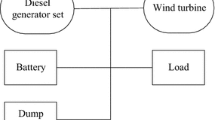The paper discusses the problems of organizing the joint operation of several electric power control systems as a part of a microgrid. The microgrid is described as an object of electric power, and its brief historical background is provided. Apossible solution for regulating the optimal power of objects with distributed generation is proposed, established on the use of a fuzzy-logic regulator based on the algorithm of fuzzy Mamdani inference, and its flowchart is presented. A simulation is performed on the microgrid operation, comprising diesel generators and electric energy storage systems. The adequacy of the model and the regulator is tested during the emergency mode simulation, and the correctness of their actions is evaluated using the Matlab-Simulink program.
Similar content being viewed by others
References
City of Binghamton Community Microgrid. Comprehensive Feasibility Study. Project summary, Bridgestone Associates, Ltd. https://brdgstn.com/wp-content/uploads/2019/12/Bridgestone-Binghamton-Microgrid-Project-Summary.pdf
G. P. Pavlyuk, A. K. Abd-Elrahim, and V. A. Shikhin, “Formulation of a complex optimization problem for constructing microgrids of the Arctic enclave in a multi-agent representation,” Ross. Arktika, No. 1, 52 – 64 (2020).
A. Yu. Leonenkov, Fuzzy Modeling in MATLAB and FuzzyTech [in Russian], BHV, St. Petersburg (2003).
V. A. Alekseev, A. V. Lukyanov, “Mathematical modeling of the technical condition of a power transformer,” Sovr. Tekhnol. Sist. Anal. Model., No. 3, 57 – 67 (2010).
A. M. Gashimov, G. B. Guliyev, and N. R. Rakhmanov, “Improved fuzzy logic algorithm for controlling reactive power and voltage in distribution networks,” Énerget. Izv. Vuzov. Énerg. Ob’’ed. SNG, No. 2, 29 – 39 (2014).
T. B. Lopez-Garcia, A. Coronado-Mendoza, and J. A. Dominguez-Navarro, “Artificial neural networks in microgrids, a review,” Eng. Appl. Artif. Intell., 95, 14 – 20 (2020).
L. Roine, K. Therani, Y. Sahraei Manjili, and M. Jamshidi, “Microgrid energy management system using fuzzy logic control,” in: World Autom. Congr. (WAC) (2014), pp. 462 – 467.
S. Angalaeswari, O. V. Gnana Swathika, V. Ananthakrishnan, J. L. Febin Daya, and K. Jamun, “Efficient power management of grid operated microgrid using fuzzy logic controller (FLC),” Energy Proc., 117, 268 – 274 (2017).
D. Rutkovskaya, M. Pilinsky, and L. Rutkovsky, Neural Networks, Genetic Algorithms, and Fuzzy Systems [Russian translation], Goryachaya liniya — Telekom, Moscow (2006).
H. B. Guliyev, Z. I. Farkhadov, and J. F. Mammadov, “System of automatic regulation of reactive power by means of fuzzy logic,” RT&A, No. 2(37), 22 – 31 (2015).
Author information
Authors and Affiliations
Corresponding author
Additional information
Translated from Élektricheskie Stantsii, No. 4, April 2022, pp. 34 – 39. DOI: https://doi.org/10.34831/EP.2022.1089.4.006
Rights and permissions
Springer Nature or its licensor (e.g. a society or other partner) holds exclusive rights to this article under a publishing agreement with the author(s) or other rightsholder(s); author self-archiving of the accepted manuscript version of this article is solely governed by the terms of such publishing agreement and applicable law.
About this article
Cite this article
Dimitriev, A.A., Mikheev, G.M. Application of Fuzzy Logic to Control the Optimal Electrical Mode of a Microgrid. Power Technol Eng 56, 447–452 (2022). https://doi.org/10.1007/s10749-023-01535-7
Published:
Issue Date:
DOI: https://doi.org/10.1007/s10749-023-01535-7




